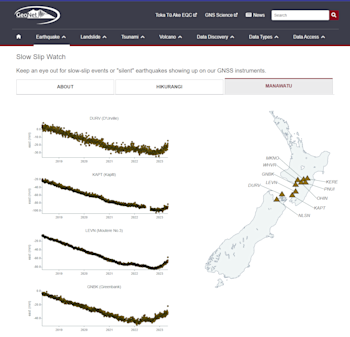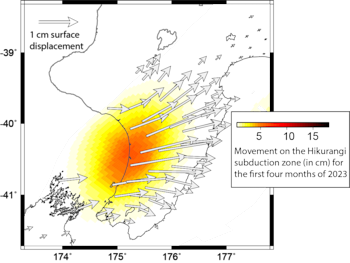
Checking in on our active Kāpiti and Manawatū slow slip earthquakes
In January we investigated ongoing slow slip events that our sensors have been detecting beneath the North Island, in Kāpiti and Manawatū. Today we check in on this activity and explore a possible link to the recent Pōrangahau earthquake sequence.
The Hikurangi subduction zone – the boundary between the Australian and Pacific Plates – extends along Aotearoa New Zealand’s east coast and dives westward underneath the North Island. We frequently identify slow-slip events on the Hikurangi subduction zone.
Slow slip events (SSE) are like earthquakes in slow motion, unfolding over weeks to months, and they cannot be felt by humans. They are detected by GeoNet’s network of continuously operating Global Navigation Satellite System (GNSS) stations (commonly referred to as GPS) that track millimetre-level movement of the land on a daily basis.
Our most recent long-term slow slip event started beneath the Manawatū region about a year and a half ago and is still going strong. Based on the behaviour of previous slow slip events in this area, we expect this one to continue through much of this year.
What has been happening recently?
In the last few months, we have also recorded new activity in the subduction plate boundary beneath the Kāpiti region. We have not seen a substantive slow slip event like this in the Kāpiti area since the one that was triggered in late 2016 by the Kaikōura earthquake. Just as the Manawatū, Kāpiti slow slip events tend to happen every five years or so, so the current activity was not unexpected.
The Manawatū and Kāpiti slow slip events have been very active so far this year, releasing energy equivalent to a Magnitude 6.9 earthquake over the past four months. The Hikurangi subduction plate boundary has moved 7 cm during this time, which is approximately six times faster than the Pacific and Australian plates typically move past each other. This year, most of the slow slip movement between the plates has been taking place 25-40 km deep beneath the Earth's surface.
Could it be possible that the ongoing Manawatū slow slip event has played a role in triggering the sequence of earthquakes observed recently near Pōrangahau?
The Pōrangahau earthquake sequence appears to have occurred on (or very close to) the Hikurangi subduction plate boundary. When slow slip events occur, they relieve a lot of pent-up stress on the subduction plate boundary. At the same time, they can increase stress on other nearby portions of the plate boundary. So yes, it is possible that the ongoing SSE could have played a part in triggering the ongoing Porangahau sequence.
The active Manawatū slow slip has now moved to the east as far as Dannevirke, which is just ~40 km from where the Pōrangahau earthquake sequence occurred in late April. We have also seen similar types of earthquake sequences in the Pōrangahau region during previous slow slip events.
Some of the GNSS sites closest to the Manawatū and Kapiti SSEs have undergone as much as 1.5 cm of horizontal displacement and 1 cm of upward displacement since the beginning of 2023.
Learn More:
- Watch our video explaing what slow slip events are
- View the latest GNSS movement on our website
- January 2023 slow slip update
- July 2022 Manawatū slow slip update
Slow-slip events are a great reminder that we Kiwis live on a very active tectonic plate boundary!
If you feel an earthquake: Drop, Cover and Hold. If you are near the coast and you feel a Long OR Strong earthquake, get to higher ground or as far inland as possible once the shaking has stopped in case a tsunami has been generated.
For more information on how to get you and your whānau prepared, visit the National Emergency Management Agency’s website getready.govt.nz.
For information on how to prepare your house for earthquakes, check out Toka Tū Ake EQC’s advice for homeowners and renters.
Attributable to: Laura Wallace – GNS Science Geophysicist
Media enquiries: media@gns.cri.nz or 021 574 541




